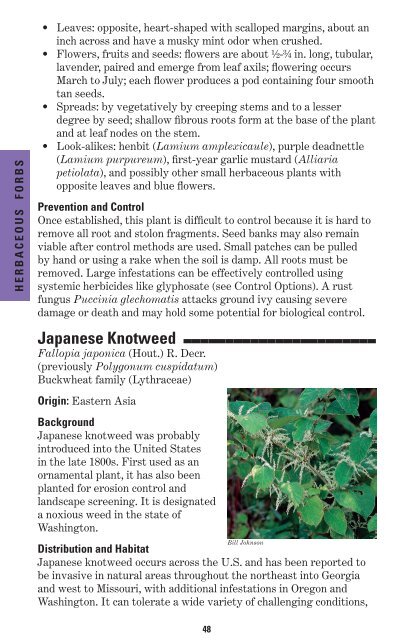Plant Invaders of Mid-Atlantic Natural Areas - National Park Service
Plant Invaders of Mid-Atlantic Natural Areas - National Park Service
Plant Invaders of Mid-Atlantic Natural Areas - National Park Service
Create successful ePaper yourself
Turn your PDF publications into a flip-book with our unique Google optimized e-Paper software.
HERBACEOUS FORBS<br />
• Leaves: opposite, heart-shaped with scalloped margins, about an<br />
inch across and have a musky mint odor when crushed.<br />
• Flowers, fruits and seeds: flowers are about ½-¾ in. long, tubular,<br />
lavender, paired and emerge from leaf axils; flowering occurs<br />
March to July; each flower produces a pod containing four smooth<br />
tan seeds.<br />
• Spreads: by vegetatively by creeping stems and to a lesser<br />
degree by seed; shallow fibrous roots form at the base <strong>of</strong> the plant<br />
and at leaf nodes on the stem.<br />
• Look-alikes: henbit ( Lamium amplexicaule), purple deadnettle<br />
(Lamium purpureum), first-year garlic mustard (Alliaria<br />
petiolata), and possibly other small herbaceous plants with<br />
opposite leaves and blue flowers.<br />
Prevention and Control<br />
Once established, this plant is difficult to control because it is hard to<br />
remove all root and stolon fragments. Seed banks may also remain<br />
viable after control methods are used. Small patches can be pulled<br />
by hand or using a rake when the soil is damp. All roots must be<br />
removed. Large infestations can be effectively controlled using<br />
systemic herbicides like glyphosate (see Control Options). A rust<br />
fungus Puccinia glechomatis attacks ground ivy causing severe<br />
damage or death and may hold some potential for biological control.<br />
Japanese Knotweed _______________________<br />
Fallopia japonica (Hout.) R. Decr.<br />
(previously Polygonum cuspidatum)<br />
Buckwheat family (Lythraceae)<br />
Origin: Eastern Asia<br />
Background<br />
Japanese knotweed was probably<br />
introduced into the United States<br />
in the late 1800s. First used as an<br />
ornamental plant, it has also been<br />
planted for erosion control and<br />
landscape screening. It is designated<br />
a noxious weed in the state <strong>of</strong><br />
Washington.<br />
Distribution and Habitat<br />
Japanese knotweed occurs across the U.S. and has been reported to<br />
be invasive in natural areas throughout the northeast into Georgia<br />
and west to Missouri, with additional infestations in Oregon and<br />
Washington. It can tolerate a wide variety <strong>of</strong> challenging conditions,<br />
48<br />
Bill Johnson

















